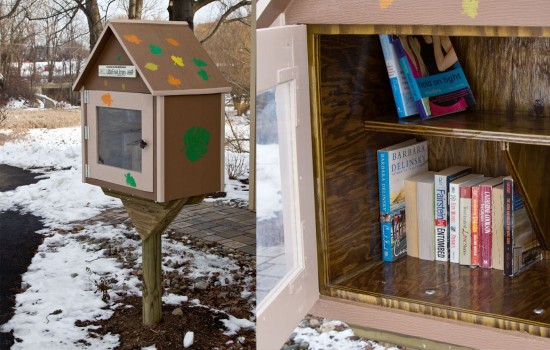Littlest Libraries of the Future
About two years ago, a “Free Bookstore” opened near me. Needless to say, I’ve been there even more often than to my local library. This year there’s a new trend.
When my college alumni magazine, “On Wisconsin,” arrived this winter it contained an article titled “It’s a Mailbox…It’s a Bird House…No, Wait, It’s a Library.”
The idea is to house free books, not in retail places of business, but in “quirky little buildings on posts”. The Little Free Library movement started when Todd Bol, a school teacher, put up a book box in front of his house in Hudson, Wisconsin in 2009. Bol’s Little Free Library looked like a miniature one-room schoolhouse.
The magazine article includes photos of Todd Bol and several Little Free Library boxes in and around Madison, Wisconsin. Being in Wisconsin, most are made of sturdy boards and have glass windows to keep the books warm and dry.
Wisconsin’s little library boxes feature carvings of cows, of course. Some boxes look like barns. Some bear images of fruit, gardens, wildflowers with birds, Inuit designs, and helpful reminders like “Slow” and “Relax”.
Little Free Library boxes also feature clever artwork, such as a open children’s picture book on the roof that begins “Once upon a time”. There’s even an old-time red phone booth with shelves inside mounted on a wood pole.
Topping the phone booth in terms of size is what looks like a food truck or mobile highway blllboard on two wheels. It appears to have been built from recycled barn wood. Recycling is a major impetus behind the creation of these libraries. In New Orleans, book lovers are using debris from Hurricane Katrina to build Little Free Libraries.
These boxes are way more than a local movement. Imagine my surprise when a former neighbor in my hometown in Pennsylvania sent a photo this week that he took of a Little Free Library near our old high school. There are thousands of little libraries popping up everywhere.
What’s the difference between little libraries and free bookstores?
Free bookstores
Free bookstores, like regular bookstores, operate on a commercial basis. The owner takes donations of books and pulls out ones that are salable. The rest are free to the community during the limited hours (weekends here) the free bookstore is open.
Obviously, this business model is pretty marginal. It costs money to hire employees to process and shelve books even at low wages and to keep a storefront open even in a low-rent commercial part of town. In addition, free bookstores aren’t in the easiest location for everyone to get to.
Little Free Libraries
Little Free Libraries have many advantages. They are not-for-profit enterprises run entirely by volunteers. The volunteers own the locations for the libraries, build or pay others to build them, and their little libraries are open 24/7.
Furthermore, unlike the free book area at my local recycling center, there are no scavengers lurking out front ready to grab your box or tear the books from your hands as you arrive to donate them.
The decentralized locations of Little Free Libraries and their lack of need for a librarian or other attendant to be present to check out books are major strengths. Older people, children, and others without automobiles will have easy access to books. The visit to a little library can be a one time thing too – the books never need be brought back. If you want, you can just put them in a little library nearer to you.
However, at least one community considered the lack of oversight to be a weakness of Little Free Libraries. Whitefish Bay, Wisconsin is said to have banned Little Free Library boxes for fear they would collect “smutty” books.
What will be the impact of little libraries on libraries and bookstores?
It isn’t likely Little Free Libraries will put traditional libraries or bookstores out of business soon. The small selection in a Little Free Library cannot even compete with that of a bookmobile. If you are performing a “known item” search for a book title or author, little libraries won’t work for you. The book selection at little libraries is usually no more than a bookshelf or two or three.
On the other hand, even in a larger library or a bookstore, the principle of “serendipity” (sometimes called “the law of attraction”) often leads an intuitive person to find exactly the right kind of book they need by browsing. There’s no reason Little Free Libraries couldn’t produce a similar result for some who stop by looking for new ideas or something interesting to read.
Because books at little libraries are donated by neighbors and passerbys, they may vary from what is in a library or bookstore. On the other hand, libraries themselves may want to put Little Free Libraries out in front to attract attention to what’s inside the big library buiding.
What is their importance for authors?
The whole idea behind the Little Free Library movement is not to get rid of books you don’t need and can’t sell. It’s to provide readers easy access to books and encourage people around the world to read more books. The more people read, the better the world will be for authors as well as readers.
In addition, a little library may be the perfect place for you begin to circulate your book in your local community. Word-of-mouth is the best way to promote book sales. Consider putting a copy of your book in a nearby Little Free Library and see how quickly it gets taken off the shelf. Create a review copy containing tear-out postage paid postcards if you want to encourage feedback before you finish your book.
Online Access to Little Libraries
Personally I think the idea of an online Little Free Library network is great. Almost anyone with a computer can get “property rights” to space online where they can put up virtual Little Free Library boxes to promote the real things.
Some owners have set up Facebook pages to promote their own Little Free Libraries and those of other “librarians”. It would be easy to do the same on a web site or a blog. Google maps the locations of Little Libraries using GPS coordinates for easy finding while traveling.
In addition, many organizations are sponsoring the construction of Little Free Libraries right now. AARP funded a project for serving older Americans. The Give It Forward Team (G.I.F.T.) is funding libraries worldwide in places where people can’t afford to build them.
This movement may not last past the lifetime of the print book, but it certainly will be a lot of fun while it does! For more information about Little Free Libraries, see littlefreelibrary.org.
Next time: Largest Libraries of the Future
 One Response
One Response 






Nancy,
Just a note to let you know how much I enjoyed your piece on Little Free Libraries as well as your website, blog and other work. You clearly know your stuff! We always appreciate it when someone sees the value of what this little project is up to. Thanks for the boost! –Rick B., Co-founder of littlefreelibrary.org